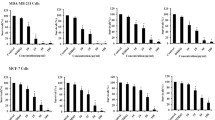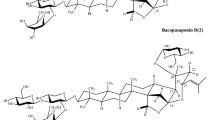Abstract
Centaurea bruguierana, of the Asteraceae family, has a long history of use in traditional medicines for the treatment of various ailments. However, the anticancer activity and underlying mechanisms have not yet been assessed. The C. bruguierana was extracted with methanol and fractionated into four different fractions. Different cancer cells and one non-cancerous were used to examine the cytotoxic effects of these fractions using MTT assay. The most potent fraction, C. bruguierana ethyl acetate fraction (CB EtOAc), was explored for its effects on cell cycle progression and apoptosis induction by Hoechst staining and annexin V-PI double staining in MCF-7 cells. The expression of apoptosis-related genes was quantified by RT-PCR. Of all fractions, CB EtOAc was found to have the strongest antiproliferative activity (IC50 = 10 μg/mL) against MCF-7 cells. The antiproliferative activity of the CB EtOAc fraction against MCF-7 was correlated with arrested of cell cycle in the G1 phase, nuclear fragmentation, and the exposure of phosphatidylserine. The induction of apoptosis by CB EtOAc in MCF-7 cells was also associated with an increase in the Bax/Bcl-2 ratio and higher expression of caspases. Overall, our results demonstrated that CB EtOAc showed apoptosis-inducing effects, suggesting that C. bruguierana may be a promising source for a novel chemotherapeutic agents for the treatment of breast cancer.





Similar content being viewed by others
References
Bray F, Ferlay J, Soerjomataram I, Siegel RL, Torre LA, Jemal A (2018) Global cancer statistics 2018: GLOBOCAN estimates of incidence and mortality worldwide for 36 cancers in 185 countries. CA: Cancer J Clin 68(6):394–424. https://doi.org/10.3322/caac.21492
Liu RH (3485s) Potential synergy of phytochemicals in cancer prevention: mechanism of action. J Nutr 134(12 Suppl):3479s–3485s. https://doi.org/10.1093/jn/134.12.3479S
Pezzani R, Salehi B, Vitalini S, Iriti M, Zuñiga FA, Sharifi-Rad J, Martorell M, Martins N (2019) Synergistic effects of plant derivatives and conventional chemotherapeutic agents: an update on the cancer perspective. Medicina (Kaunas) 55(4):110. https://doi.org/10.3390/medicina55040110
Korga A, Józefczyk A, Zgórka G, Homa M, Ostrowska M, Burdan F, Dudka J (2017) Evaluation of the phytochemical composition and protective activities of methanolic extracts of Centaurea borysthenica and Centaurea daghestanica (Lipsky) Wagenitz on cardiomyocytes treated with doxorubicin. Food Nutr Res 61(1):1344077–1344077. https://doi.org/10.1080/16546628.2017.1344077
Çelik S, Rosselli S, Maggio AM, Raccuglia RA, Uysal I, Kisiel W, Michalska K, Bruno M (2006) Guaianolides and lignans from the aerial parts of Centaurea ptosimopappa. Biochem Syst Ecol 34(4):349–352
Flamini G, Pardini M, Morelli I, Ertugrul K, Dural H, Bagci Y, Kargioglu M (2002) Flavonoid glycosides from Centaurea pseudoscabiosa subsp. pseudoscabiosa from Turkey. Phytochemistry 61(4):433–437
Reyhan A, KÜPELI E, ERGUN F (2004) The biological activity of Centaurea L. species. Gazi Uni J of Sci 17(4):149–164
Khammar A, Djeddi S (2012) Pharmacological and biological properties of some Centaurea species. Eur J Sci Res 84(3):398–416
Shoeb M, Jaspars M, MacManus SM, Celik S, Nahar L, Kong-Thoo-Lin P, Sarker SD (2007) Anti-colon cancer potential of phenolic compounds from the aerial parts of Centaurea gigantea (Asteraceae). J Nat Med 61(2):164
Özçelik B, Gürbüz I, Karaoglu T, Yeşilada E (2009) Antiviral and antimicrobial activities of three sesquiterpene lactones from Centaurea solstitialis L. ssp. solstitialis. Microbiol Res 164(5):545–552
Koca U, Süntar IP, Keles H, Yesilada E, Akkol EK (2009) In vivo anti-inflammatory and wound healing activities of Centaurea iberica Trev. ex Spreng. J Ethnopharmacol 126(3):551–556
Mandaville JP, Mandaville JP (1990) Flora of Eastern Saudi Arabia. Kegan Paul International, London
Mabberley DJ (1997) The plant-book: a portable dictionary of the vascular plants. Cambridge University Press, Cambridge
Khanavi M, Rajabi A, Behzad M, Hadjiakhoondi A, Vatandoost H, Abaee MR (2011) Larvicidal activity of Centaurea bruguierana ssp. Belangerana against Anopheles stephensi Larvae. IJPR 10(4):829–833
Khanavi M, Ahmadi R, Rajabi A, Arfaee SJ, Hassanzadeh G, Khademi R, Hadjiakhoondi A, Beyer C, Sharifzadeh M (2012) Pharmacological and histological effects of Centaurea bruguierana ssp. belangerana on indomethacin-induced peptic ulcer in rats. J Nat Med 66(2):343–349
Kalkhorani M, Hadjiakhoondi A, Yassa N, Amin M, Damankash S, Moradkhani F, Vazirian M (2019) Bio-guided fractionation of Centaurea bruguierana subsp. belangeriana extract based on anti-Helicobacter pylori activity. Res J Pharmacogn 7(1):61–67
Ostad SN, Rajabi A, Khademi R, Farjadmand F, Eftekhari M, Hadjiakhoondi A, Khanavi M (2016) Cytotoxic potential of Centaurea bruguierana ssp. belangerana: the MTT assay. Acta Med Iran 54(9):583–589
Mirzahosseini G, Manayi A, Khanavi M, Safavi M, Salari A, Madjid Ansari A, San'ati H, Vazirian M (2019) Bio-guided isolation of Centaurea bruguierana subsp. belangerana cytotoxic components. Nat Prod Res 33(11):1687–1690. https://doi.org/10.1080/14786419.2018.1428590
Abutaha N, Nasr FA, Mohammed AZ, Semlali A, Al-Mekhlafi FA, Wadaan MA (2019) Calendula arvensis L. as an anti-cancer agent against breast cancer cell lines. Mol Biol Rep 46(2):2187–2196. https://doi.org/10.1007/s11033-019-04672-3
Alqahtani AS, Nasr FA, Noman OM, Farooq M, Alhawassi T, Qamar W, El-Gamal A (2020) Cytotoxic evaluation and anti-angiogenic effects of two furano-sesquiterpenoids from commiphora myrrh resin. Molecules 25(6):1318. https://doi.org/10.3390/molecules25061318
Harada K, Kawaguchi S, Supriatno KY, Yoshida H, Sato M (2005) S-1, an oral fluoropyrimidine anti-cancer agent, enhanced radiosensitivity in a human oral cancer cell line in vivo and in vitro: involvement possibility of inhibition of survival signal, Akt/PKB. Cancer Lett 226(2):161–168. https://doi.org/10.1016/j.canlet.2004.12.048
Greenwell M, Rahman PKSM (2015) Medicinal plants: their use in anticancer treatment. Int J Pharm Sci Res 6(10):4103–4112. https://doi.org/10.13040/IJPSR.0975-8232.6(10).4103-12
Suffness M, Pezzuto J (1990) Methods in plant biochemistry: assays for bioactivity. Academic Press, London, pp 71–133
YIRTICI Ü, GÖGER F, SARIMAHMUT M, ERGENE A (2017) Cytotoxic and apoptotic effects of endemic Centaurea fenzlii Reichardt on the MCF-7 breast cancer cell line. Turk J Biol 41(2):370–377
Evan GI, Vousden KH (2001) Proliferation, cell cycle and apoptosis in cancer. Nature 411(6835):342–348. https://doi.org/10.1038/35077213
Diaz-Moralli S, Tarrado-Castellarnau M, Miranda A, Cascante M (2013) Targeting cell cycle regulation in cancer therapy. Pharmacol Ther 138(2):255–271
Sherr CJ, Bartek J (2017) Cell cycle–targeted cancer therapies. Annu Rev Cancer Biol 1:41–57
Singh RP, Dhanalakshmi S, Agarwal R (2002) Phytochemicals as cell cycle modulators a less toxic approach in halting human cancers. Cell Cycle 1(3):155–160
Chirumbolo S, Bjørklund G, Lysiuk R, Vella A, Lenchyk L, Upyr T (2018) Targeting cancer with phytochemicals via their fine tuning of the cell survival signaling pathways. Int J Mol Sci 19(11):3568. https://doi.org/10.3390/ijms19113568
Kaufmann SH, Earnshaw WC (2000) Induction of apoptosis by cancer chemotherapy. Exp Cell Res 256(1):42–49. https://doi.org/10.1006/excr.2000.4838
Ricci MS, Zong W-X (2006) Chemotherapeutic approaches for targeting cell death pathways. Oncologist 11(4):342–357. https://doi.org/10.1634/theoncologist.11-4-342
Hanahan D, Weinberg RA (2000) The hallmarks of cancer. Cell 100(1):57–70. https://doi.org/10.1016/s0092-8674(00)81683-9
Sun SY, Hail N Jr, Lotan R (2004) Apoptosis as a novel target for cancer chemoprevention. J Natl Cancer Inst 96(9):662–672. https://doi.org/10.1093/jnci/djh123
Millimouno FM, Dong J, Yang L, Li J, Li X (2014) Targeting apoptosis pathways in cancer and perspectives with natural compounds from mother nature. Cancer Prev Res (Phila) 7(11):1081–1107. https://doi.org/10.1158/1940-6207.Capr-14-0136
Hanahan D, Weinberg RA (2011) Hallmarks of cancer: the next generation. Cell 144(5):646–674. https://doi.org/10.1016/j.cell.2011.02.013
Kaur V, Kumar M, Kumar A, Kaur K, Dhillon VS, Kaur S (2018) Pharmacotherapeutic potential of phytochemicals: implications in cancer chemoprevention and future perspectives. Biomed Pharmacother 97:564–586. https://doi.org/10.1016/j.biopha.2017.10.124
Delbridge AR, Grabow S, Strasser A, Vaux DL (2016) Thirty years of BCL-2: translating cell death discoveries into novel cancer therapies. Nat Rev Cancer 16(2):99–109. https://doi.org/10.1038/nrc.2015.17
Edlich F (2018) BCL-2 proteins and apoptosis: recent insights and unknowns. Biochem Biophys Res Commun 500(1):26–34. https://doi.org/10.1016/j.bbrc.2017.06.190
Swanton E, Savory P, Cosulich S, Clarke P, Woodman P (1999) Bcl-2 regulates a caspase-3/caspase-2 apoptotic cascade in cytosolic extracts. Oncogene 18(10):1781–1787. https://doi.org/10.1038/sj.onc.1202490
Kayacan S, Sener LT, Melikoglu G, Kultur S, Albeniz I, Ozturk M (2018) Induction of apoptosis by Centaurea nerimaniae extract in HeLa and MDA-MB-231 cells by a caspase-3 pathway. Biotech Histochem 93(5):311–319. https://doi.org/10.1080/10520295.2017.1401662
Liu RH (3485S) Potential synergy of phytochemicals in cancer prevention: mechanism of action. J Nutr 134(12):3479S–3485S
Karna P, Chagani S, Gundala SR, Rida PC, Asif G, Sharma V, Gupta MV, Aneja R (2012) Benefits of whole ginger extract in prostate cancer. Br J Nutr 107(4):473–484
Zhang S, Won YK, Ong CN, Shen HM (2005) Anti-cancer potential of sesquiterpene lactones: bioactivity and molecular mechanisms. Curr Med Chem Anticancer Agents 5(3):239–249. https://doi.org/10.2174/1568011053765976
Ghantous A, Gali-Muhtasib H, Vuorela H, Saliba NA, Darwiche N (2010) What made sesquiterpene lactones reach cancer clinical trials? Drug Discov Today 15(15–16):668–678. https://doi.org/10.1016/j.drudis.2010.06.002
Karimian H, Fadaeinasab M, Moghadamtousi SZ, Hajrezaei M, Zahedifard M, Razavi M, Safi SZ, Mohan S, Khalifa SA, El-Seedi HR, Abdulla MA, Ali HM, Noordin MI (2015) The chemopreventive effect of Tanacetum Polycephalum against LA7-induced breast cancer in rats and the apoptotic effect of a cytotoxic sesquiterpene lactone in MCF7 cells: a bioassay-guided approach. Cell Physiol Biochem 36(3):988–1003. https://doi.org/10.1159/000430273
Babaei G, Aliarab A, Abroon S, Rasmi Y, Aziz SG (2018) Application of sesquiterpene lactone: a new promising way for cancer therapy based on anticancer activity. Biomed Pharmacother 106:239–246. https://doi.org/10.1016/j.biopha.2018.06.131
Acknowledgements
The authors extend their appreciation to the Deanship of Scientific Research at King Saud University for funding this work through research group no. RG-262.
Author information
Authors and Affiliations
Corresponding author
Ethics declarations
Conflict of interest
The authors declare that they have no conflicts of interest.
Ethical approval
This work is carried out on cell lines and there is no need for ethical clearance.
Additional information
Publisher's Note
Springer Nature remains neutral with regard to jurisdictional claims in published maps and institutional affiliations.
Rights and permissions
About this article
Cite this article
Nasr, F.A., Shahat, A.A., Alqahtani, A.S. et al. Centaurea bruguierana inhibits cell proliferation, causes cell cycle arrest, and induces apoptosis in human MCF-7 breast carcinoma cells. Mol Biol Rep 47, 6043–6051 (2020). https://doi.org/10.1007/s11033-020-05679-x
Received:
Accepted:
Published:
Issue Date:
DOI: https://doi.org/10.1007/s11033-020-05679-x




